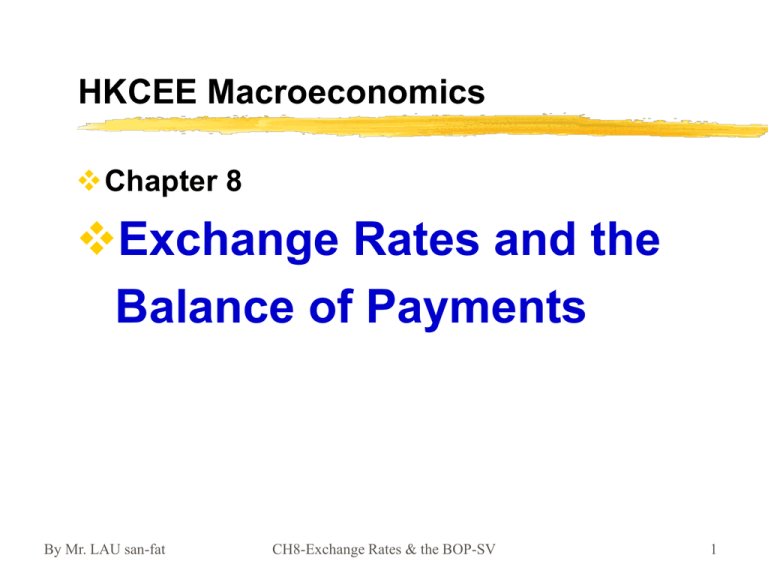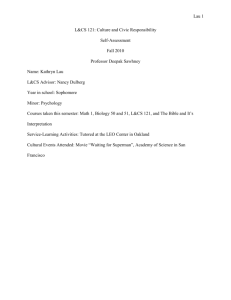CH8-Exchange Rates and the BOP-SV
advertisement

HKCEE Macroeconomics Chapter 8 Exchange Rates and the Balance of Payments By Mr. LAU san-fat CH8-Exchange Rates & the BOP-SV 1 Demand for Foreign Currencies •We demand for foreign currencies for: payment for foreign imports making foreign investments •We supply domestic currencies in the foreign exchange market in exchange for foreign currencies •D foreign Currencies S domestic currencies By Mr. LAU san-fat CH8-Exchange Rates & the BOP-SV 2 Supply of Foreign Currencies • Foreign countries demand for domestic currencies for: payment for domestic exports making domestic investments • Foreign countries supply foreign currencies in the foreign exchange market in exchange for domestic currencies • D domestic Currencies S foreign currencies Task 1: Textbook/P.214/Q.10.1 By Mr. LAU san-fat CH8-Exchange Rates & the BOP-SV 3 Exchange Rates • An exchange rate is the price of a currency in terms of another currency. • Example: US$1 = HK$7.8 HK$1 = US$0.129 The exchange rate of US dollars in terms of HK dollars is 7.8 The exchange rate of HK dollars in terms of US dollars is 0.129 By Mr. LAU san-fat CH8-Exchange Rates & the BOP-SV 4 Floating Exchange Rate System • Under the floating/flexible exchange rate system, the exchange rate of a currency is determined by its demand and supply. By Mr. LAU san-fat CH8-Exchange Rates & the BOP-SV 5 Floating Exchange Rate System • Example: US$1 = HK$8 Exchange rate of US$ (in terms of HK$) D S 8 Quantity of US$ 0 By Mr. LAU san-fat Q CH8-Exchange Rates & the BOP-SV 6 Floating Exchange Rate System • Appreciation of a currency occurs if its exchange rate rises • Example: US$1 = HK$8 US$1 = HK$9 Appreciation of a currency occurs if: its demand rises its supply falls its demand rises and supply falls By Mr. LAU san-fat CH8-Exchange Rates & the BOP-SV 7 Floating Exchange Rate System • Depreciation of a currency occurs if its exchange rate falls. • Example: US$1 = HK$8 US$1 = HK$7 Depreciation of a currency occurs if: its demand falls its supply rises its demand falls and supply rises By Mr. LAU san-fat CH8-Exchange Rates & the BOP-SV 8 Floating Exchange Rate System • Appreciation of a foreign currency implies depreciation of local currency. • Example: Before appreciation of US$: US$1 = HK$8 HK$1 = US$0.129 Appreciation of US$ (against HK$): US$1 = HK$8 US$1 = HK$9 Hence, HK$1 = US$0.129 HK$1 = US$0.111 By Mr. LAU san-fat CH8-Exchange Rates & the BOP-SV 9 Floating Exchange Rate System • Depreciation of a foreign currency implies appreciation of local currency. • Example: Before depreciation of US$: US$1 = HK$8 HK$1 = US$0.129 Depreciation of US$ (against HK$): US$1 = HK$8 US$1 = HK$7 Hence, HK$1 = US$0.129 HK$1 = US$0.143 By Mr. LAU san-fat CH8-Exchange Rates & the BOP-SV 10 Fixed Exchange Rate System • Under a fixed exchange rate system, the exchange rate of a currency is fixed by the government or monetary authority. • The fixed rate should be kept at a level different from the market rate. By Mr. LAU san-fat CH8-Exchange Rates & the BOP-SV 11 Fixed Exchange Rate System • Revaluation of a currency occurs if the fixed rate is raised. Example: US$1 = HK$8 US$1 = HK$9 • Devaluation of a currency occurs if the fixed rate is decreased. Example: US$1 = HK$8 US$1 = HK$7 Task 2: Textbook/P.217/Q.10.3 By Mr. LAU san-fat CH8-Exchange Rates & the BOP-SV 12 Linked Exchange Rate System • Functions: to govern the issuing of banknotes to help stabilize the exchange rate of HK$ in terms of US$ By Mr. LAU san-fat CH8-Exchange Rates & the BOP-SV 13 Linked Exchange Rate System • Operations: linked rate: US$1 = HK7.8 applies to the exchange of US$ for HK$ between note-issuing banks & Exchange Fund, other banks & note-issuing banks buying and selling of the Certificates of Indebtedness (CI) with US$ difference between the linked and market rates will be cleared by engaging arbitrage By Mr. LAU san-fat CH8-Exchange Rates & the BOP-SV 14 Linked Exchange Rate System • If linked rate > market rate… if market rate: US$1 = HK$7 arbitrage occurs: buying US$ at market rate (HK$7) selling US$ at linked rate (HK$7.8) buying US$ in the foreign exchange market a larger demand for US$ appreciation of US$ (say US$1 = HK$7.5) appreciation stops if ↑market rate = linked rate By Mr. LAU san-fat CH8-Exchange Rates & the BOP-SV 15 Linked Exchange Rate System • If linked rate < market rate… if market rate: US$1 = HK$9 arbitrage occurs: buying US$ at linked rate (HK$7.8) selling US$ at market rate (HK$9) selling US$ in the foreign exchange market a larger supply for US$ depreciation of US$ (say US$1 = HK$8) depreciation stops if ↓market rate = linked rate By Mr. LAU san-fat CH8-Exchange Rates & the BOP-SV 16 Effects of Changes in Exchange Rate • If foreign currency appreciates/revalues Example: Price of USA imports = US$1000 Before US$ appreciates: US$1 = HK$8 price of USA imports in terms of HK$ = HK$(8 × 1000) = HK$8000 After US$ appreciates: US$1 = HK$9 price of USA imports in terms of HK$ = HK$(9 × 1000) = HK$9000 +HK$1000 By Mr. LAU san-fat CH8-Exchange Rates & the BOP-SV 17 Effects of Changes in Exchange Rate • If foreign currency appreciates/revalues Price of foreign imports in terms of local currency will rise ↓demand for foreign imports (by local consumers) By Mr. LAU san-fat CH8-Exchange Rates & the BOP-SV 18 Effects of Changes in Exchange Rate • If foreign currency appreciates/revalues Example: Price of HK exports = HK$7800 Before US$ appreciates: US$0.125 = HK$1 price of HK exports in terms of US$ = US$(0.125 × 7800) = US$975 After US$ appreciates: US$0.111 = HK$1 price of HK exports in terms of US$ = US$(0.111 × 7800) = US$865.8 -US$109.2 By Mr. LAU san-fat CH8-Exchange Rates & the BOP-SV 19 Effects of Changes in Exchange Rate • If foreign currency appreciates/revalues Price of domestic exports in terms of foreign currency will fall ↑demand for domestic exports (by foreign countries) By Mr. LAU san-fat CH8-Exchange Rates & the BOP-SV 20 Effects of Changes in Exchange Rate • If foreign currency depreciates/devalues Example: Price of USA imports = US$1000 Before US$ appreciates: US$1 = HK$8 price of USA imports in terms of HK$ = HK$(8 × 1000) = HK$8000 After US$ depreciates: US$1 = HK$7 price of USA imports in terms of HK$ = HK$(7 × 1000) = HK$7000 -HK$1000 By Mr. LAU san-fat CH8-Exchange Rates & the BOP-SV 21 Effects of Changes in Exchange Rate • If foreign currency depreciates/devalues Price of foreign imports in terms of local currency will fall ↑demand for foreign imports (by local consumers) By Mr. LAU san-fat CH8-Exchange Rates & the BOP-SV 22 Effects of Changes in Exchange Rate • If foreign currency depreciates/devalues Example: Price of HK exports = HK$7800 Before US$ appreciates: US$0.125 = HK$1 price of HK exports in terms of US$ = US$(0.125 × 7800) = US$975 After US$ depreciates: US$0.143 = HK$1 price of HK exports in terms of US$ = US$(0.143 × 7800) = US$1115.4 +US$140.4 By Mr. LAU san-fat CH8-Exchange Rates & the BOP-SV 23 Effects of Changes in Exchange Rate • If foreign currency depreciates/devalues Price of domestic exports in terms of foreign currency will rise ↓demand for domestic exports (by foreign countries) Task 3: Textbook/P.219/MCQ 1 /P.220/MCQ 2 By Mr. LAU san-fat CH8-Exchange Rates & the BOP-SV 24 Balance of Payments (BOP) • The Balance Of Payments Account a set of statistical statements that systematically summarizes the economic transactions of an economy with the rest of the world, in a specified period of time, usu. a year or quarter By Mr. LAU san-fat CH8-Exchange Rates & the BOP-SV 25 Balance of Payments (BOP) •In the BOP Account… payments to other countries → debit side receipts by the country → credit side two major accounts: the current account the capital and financial account By Mr. LAU san-fat CH8-Exchange Rates & the BOP-SV 26 The Current Account It measures flow of real resources 1. Visible Trade, i.e. imports & exports of physical goods the balance of trade (or trade balance) = value of exports of goods-value of imports of goods = value of (domestic exports+ re-exports) -value of imports By Mr. LAU san-fat CH8-Exchange Rates & the BOP-SV 27 The Current Account 2. Invisible Trade, i.e. imports & exports of services the balance of invisible trade = value of exports of services - value of imports of services Task 4: Textbook/P.221/MCQ 3 By Mr. LAU san-fat CH8-Exchange Rates & the BOP-SV 28 The Current Account 3. Income Factor incomes Net factor income from abroad = factor incomes earned by residents from outside the economy -factor incomes earned by non-residents within the economy Major items: direct investment income portfolio investment income other investment income compensation of employees By Mr. LAU san-fat CH8-Exchange Rates & the BOP-SV 29 The Current Account 4. Current Transfers unilateral flow of real and financial resources Including gifts, grants, remittance & aids If linked to acquiring or disposing fixed assets, cash transfer is regarded as current transfer. Task 5: Textbook/P.223/MCQ 4 /P.224/MCQ 5 /P.225/Q.10.5 By Mr. LAU san-fat CH8-Exchange Rates & the BOP-SV 30 The Capital & Financial Account Components: capital transfers non-produced & non-financial assets Investments reserve assets Remark: Detailed classifications of the capital and financial account is NOT required in the HKCEE syllabus.) By Mr. LAU san-fat CH8-Exchange Rates & the BOP-SV 31 The Capital & Financial Account the Capital Account It measures external transactions in capital transfers and non-produced/non-financed assets (such as patents & copyrights). A capital transfer is a transfer of ownership of a fixed asset or forgiveness of a liability. Capital inflows lead to credit while outflows lead to a debit. By Mr. LAU san-fat CH8-Exchange Rates & the BOP-SV 32 The Capital & Financial Account the Financial Account It shows how an economy’s external transactions are financed. 1. Direct Investment: It aims at acquiring lasting interest & influence in managing an overseas enterprise Example: external investment in (overseas) real estate By Mr. LAU san-fat CH8-Exchange Rates & the BOP-SV 33 The Capital & Financial Account the Financial Account 2. Portfolio Investment: It refers to investment in non-resident equities (i.e. stocks & shares), debt securities (e.g. bonds) and financial derivatives (e.g. options & warrants) It involves NO lasting interest or influence in managing an overseas enterprise By Mr. LAU san-fat CH8-Exchange Rates & the BOP-SV 34 The Capital & Financial Account the Financial Account 3. Other Investment: It refers to other financial claims (NOT classified as direct investment, portfolio investment or reserve assets) on and liabilities to non-residents. Examples: short-term & long-term non-marketable loans & deposits. By Mr. LAU san-fat CH8-Exchange Rates & the BOP-SV 35 The Capital & Financial Account the Financial Account 4. Reserve Assets: It consists of external assets (e.g. gold and foreign currencies) for (1) directly financing payment imbalances (i.e. BOP deficit/surplus) and (2) for indirectly regulating the magnitude of such imbalances by intervening the exchange rate of an economy in the foreign exchange markets. It is readily available to and controlled by monetary authorities of an economy Task 6: Textbook/P.228/Q.10.6 By Mr. LAU san-fat CH8-Exchange Rates & the BOP-SV 36 The BOP Deficit or Surplus by excluding the changes in reserve assets, we may have BOP imbalances. BOP Financial Status Balanced BOP Total receipts = Total payments BOP Deficit Total receipts < Total payments BOP Surplus Total receipts >7Total payments Task 7: Textbook/P.229/MCQ By Mr. LAU san-fat CH8-Exchange Rates & the BOP-SV 37 BOP Imbalances & Reserve Assets Changes in Reserve Assets With BOP deficit: BOP deficit → outflow of gold/foreign currencies → credit the account → the BOP account gets balanced With BOP surplus: BOP surplus → inflow of gold/foreign currencies → debit the account → the BOP account gets balanced By Mr. LAU san-fat CH8-Exchange Rates & the BOP-SV 38 BOP and BOP Account An economy may have balance of payment (BOP) deficit, surplus or balance, depending total receipts and total payments. However, according to accounting conventions (double-entry), the sum of all credit items is always equal to the sum of all debit items, the balance of payment (BOP) account is always in balance. Closer Look 10.5: Textbook/P.229-230 By Mr. LAU san-fat CH8-Exchange Rates & the BOP-SV 39







